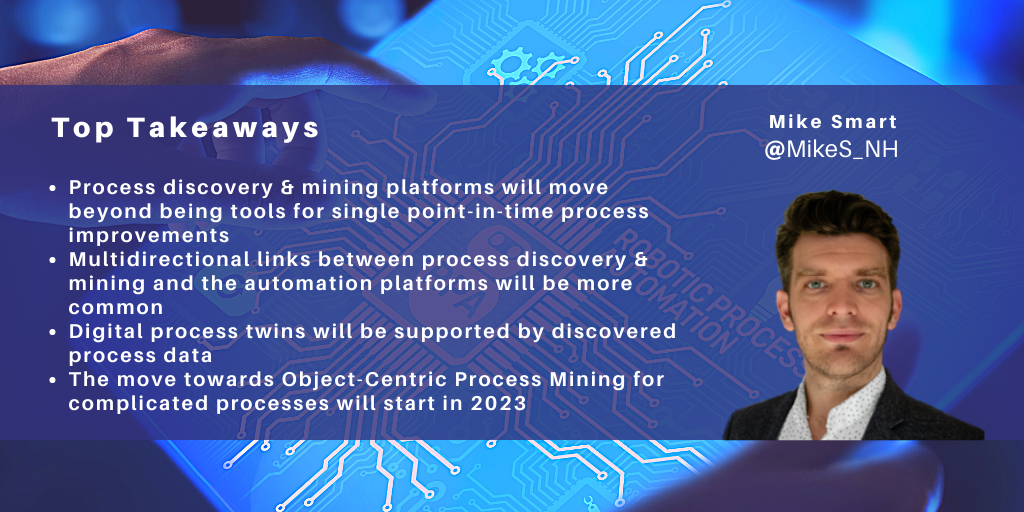posted on Jan 05, 2023 by Mike Smart

Process discovery and mining platforms, which examine organizations’ process data as part of transformation initiatives, have become an increasingly critical part of process automation and reengineering journeys.
Here I look at what to expect in the process discovery and mining space in 2023 and beyond.
Continuous Monitoring
Traditionally we have seen COEs use process discovery and mining to focus solely on single point-in-time process improvements as part of the transformation journey. Because of this, when an improved process is put into place the focus (and licenses) for the process discovery and mining suites are moved onto the next project.
In 2023, we predict that these solutions will be used to support more process analysis on an ongoing basis, with licenses being used on already reengineered processes to support KPI monitoring and ongoing process improvement. There are certainly features being built into the platforms and pricing models that are reenforcing this move, such as being able to use process discovery platforms to train users on parts of processes that cannot be automated, and unlimited usage licenses that aren’t tied to the amount of users or the amount of process data ingested.
In this way, process discovery and mining solutions can provide a real-time view of actual process performance, augmenting business process management (BPM) platforms.
Automation and Low Code Application Development Links
Process discovery and mining have always been great lead-ins for automation, revealing what processes are in place before automating them; however, that connection has mainly been one way, i.e. process discovery and mining platforms sending over the skeletons of a process to automation platforms to build an automation.
In 2023, we see process discovery platforms implementing more functionality in the reverse direction to take automation logs from the automation tools back into the discovered process to track the overall performance of the process on an ongoing basis, whether the steps of the process are automated or performed by a human.
Likewise, when a process cannot be fully automated and requires human effort, automation platforms are implementing low code applications to collect the necessary information. We envisage the process discovery and mining platforms not only building skeletons of the processes for automation, but also building suggestions from low code applications.
Digital Process Twins
Usually when we refer to digital twins we are talking about a digital representation of a manual process enabled by IoT as part of industry 4.0. However, at the end of last year, we saw one or two vendors moving towards the creation of digital process twins for business operations.
The digital process twin is the culmination of continuous monitoring of both a process and its automation. Using these features, process understanding solutions can be the future of BPM, providing real-time tracking of the performance of a process, and they can enable opportunities like preventative maintenance, leveraging root cause analysis to find when a process is showing signs that it is straying from the target model.
Object-Centric Process Mining
Traditional process mining ascribes a single case notation for every step of the process, but this isn’t the best fit for every process.
For example, in car manufacturing, the production of a car could be held up by the materials for the glass in the windows if single case notation is used. A car manufacturer will not be ascribing the same case notation for silicon arriving at the factory to the car that will eventually be fitted with windows made from that silicon consignment.
In object-centric process mining (OCPM) you would not use a single case notation as the only linking piece in a process. Instead, the case notation ceases to be the be-all-and-end-all of the process and each object, each aspect of the process, is tracked individually, with its own attributes, as part of a whole process.
The object-centric process could then, in the car example, relate case numbers from user issues to the vehicle, to the order they placed, to the windscreen, and to the delivery of silicon.
Such OCPM will expand the usefulness of process discovery and mining from processes that are fairly simple and related to a single case, such as a ticket number on an email, to a more complete view of the process.
***
In this quick look at the future of process discovery and mining, we acknowledge that the features described here may not be the core application of these platforms before the end of 2023, as organizations will continue to use existing functionality to target the bulk of legacy processes requiring quick fixes to reduce costs and perform one-off improvements to processes.

